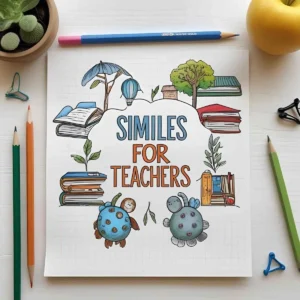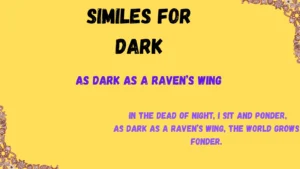The Charm of Similes in Clarifying Ideas 💡
Similes are like keys unlocking a treasure chest, using “like” or “as” to make explanations vivid and memorable by comparing two unlike things. They transform a plain “for example” into a colorful bridge that connects ideas to imagination, turning “I’ll explain with an example” into “I’ll shine a light on this, like a lighthouse guiding ships.” Similes make clarifications engaging, whether in essays, presentations, or casual chats. By replacing the mundane “for example,” they add flair and clarity. Ever noticed how a clever simile makes an idea stick? Let’s explore 25 similes for “for example” to brighten your explanations across all walks of life! 📣
Similes for For Example: 25 Creative Comparisons
These 25 similes reimagine “for example” as vibrant, relatable images, capturing how we clarify, teach, or connect ideas. Organized into thematic groups, each simile includes a meaning, a contextual example, and a specific application for writing, speaking, or joking. Let’s make explaining fun!
Illuminating Ideas 💡
Similes for clarifying concepts with light or revelation.
- It’s like a flashlight, shining on the point.
Meaning: “For example” highlights an idea clearly, like a flashlight cuts through darkness.
Example: In a science class, “To explain gravity, it’s like a flashlight shining on Newton’s apple falling.”
Application: Use in a lesson plan or blog post to clarify complex topics, e.g., “It’s like a flashlight shining on why recycling matters.” - It’s like a spotlight, beaming on the main idea.
Meaning: “For example” draws attention to a key point, like a spotlight on a stage.
Example: In a presentation, “To show our success, it’s like a spotlight beaming on our sales growth.”
Application: Perfect for business pitches or Instagram captions about achievements. - It’s like a lantern, glowing to guide understanding.
Meaning: “For example” gently illuminates, like a lantern lights a path.
Example: In a tutoring session, “To clarify fractions, it’s like a lantern glowing on splitting a pizza.”
Application: Use in educational videos or tweets about teaching moments. - It’s like a spark, igniting clarity in the mind.
Meaning: “For example” triggers sudden understanding, like a spark starts a fire.
Example: In a book club, “To explain the theme, it’s like a spark igniting the hero’s journey.”
Application: Great for literary discussions or essays to introduce key points. - It’s like a beacon, signaling the idea’s core.
Meaning: “For example” points directly to the essence, like a beacon guides ships.
Example: In a debate, “To prove my point, it’s like a beacon signaling recycling’s impact.”
Application: Use in speeches or op-eds to emphasize arguments.
Building Bridges 🌉
Similes for connecting ideas to make them relatable.
- It’s like a bridge, linking thoughts to clarity.
Meaning: “For example” connects concepts to understanding, like a bridge spans a river.
Example: In a team meeting, “To explain our goal, it’s like a bridge linking effort to results.”
Application: Use in workplace emails or LinkedIn posts to connect strategies to outcomes. - It’s like a ladder, climbing to the main point.
Meaning: “For example” steps toward clarity, like a ladder reaches higher ground.
Example: In a blog, “To show healthy habits, it’s like a ladder climbing to daily walks.”
Application: Perfect for lifestyle blogs or health talks to illustrate steps. - It’s like a rope, tying ideas together.
Meaning: “For example” binds concepts, like a rope secures a knot.
Example: In a history lesson, “To explain the war, it’s like a rope tying events to causes.”
Application: Use in academic writing or class discussions to link ideas. - It’s like a pathway, leading to understanding.
Meaning: “For example” guides listeners to the point, like a pathway through a forest.
Example: In a podcast, “To clarify budgeting, it’s like a pathway leading to saving tips.”
Application: Great for financial advice videos or casual chats about planning. - It’s like a map, charting the idea’s terrain.
Meaning: “For example” outlines a concept clearly, like a map shows directions.
Example: In a coding tutorial, “To explain loops, it’s like a map charting a program’s flow.”
Application: Use in tech blogs or tutorials to clarify processes.
Adding Flavor 🍎
Similes for making explanations vivid and engaging.
- It’s like a spice, seasoning the explanation.
Meaning: “For example” adds zest to a point, like spice enhances food.
Example: In a cooking vlog, “To show flavor balance, it’s like a spice seasoning the dish with herbs.”
Application: Use in food blogs or casual recipe chats to make points tasty. - It’s like a cherry, topping the idea with flair.
Meaning: “For example” adds a final, vibrant touch, like a cherry on a sundae.
Example: In a fashion post, “To show style, it’s like a cherry topping the outfit with a scarf.”
Application: Perfect for social media captions or style blogs to add pizzazz. - It’s like a garnish, dressing up the point.
Meaning: “For example” enhances an idea, like a garnish makes a plate pop.
Example: In an art class, “To explain shading, it’s like a garnish dressing up the sketch.”
Application: Use in creative writing or art tutorials for visual flair. - It’s like a splash, coloring the explanation.
Meaning: “For example” adds vividness, like a splash of paint on a canvas.
Example: In a storytelling workshop, “To clarify plot, it’s like a splash coloring the story’s twist.”
Application: Great for creative workshops or blog posts about writing. - It’s like a bubble, floating the idea to life.
Meaning: “For example” lifts an idea playfully, like a bubble rises in the air.
Example: In a kids’ science class, “To explain gravity, it’s like a bubble floating the ball’s fall.”
Application: Use in children’s education or fun family talks.
Emotional Connections ❤️
Similes for explanations that resonate emotionally.
- It’s like a hug, warming the listener’s mind.
Meaning: “For example” makes ideas comforting, like a hug soothes the heart.
Example: In a counseling session, “To explain empathy, it’s like a hug warming a friend’s story.”
Application: Use in motivational speeches or blogs about emotional intelligence. - It’s like a melody, harmonizing the point.
Meaning: “For example” makes ideas flow smoothly, like a melody ties notes together.
Example: In a music lesson, “To show rhythm, it’s like a melody harmonizing the beat.”
Application: Perfect for music blogs or speeches about teamwork. - It’s like a smile, brightening the explanation.
Meaning: “For example” adds friendliness, like a smile lifts a mood.
Example: In a team huddle, “To clarify our plan, it’s like a smile brightening our goal.”
Application: Use in workplace talks or social media posts for positivity. - It’s like a heartbeat, pulsing with clarity.
Meaning: “For example” drives the point home rhythmically, like a heartbeat sustains life.
Example: In a poetry reading, “To explain love, it’s like a heartbeat pulsing with her glance.”
Application: Great for romantic writing or emotional essays. - It’s like a sparkler, dazzling with insight.
Meaning: “For example” adds a burst of excitement, like a sparkler lights the night.
Example: In a brainstorm, “To show innovation, it’s like a sparkler dazzling with new ideas.”
Application: Use in creative pitches or posts about brainstorming.
Cultural and Historical Flair 🌍
Similes inspired by cultural or historical imagery for explanations.
- It’s like a scroll, unfurling ancient wisdom.
Meaning: “For example” reveals timeless insights, like a scroll shares old knowledge.
Example: In a history class, “To explain Rome, it’s like a scroll unfurling the Colosseum’s glory.”
Application: Use in historical essays or cultural talks for depth. - It’s like a drumbeat, echoing the point’s rhythm.
Meaning: “For example” emphasizes ideas with cultural resonance, like a drumbeat carries tradition.
Example: In a cultural festival, “To show dance, it’s like a drumbeat echoing the steps.”
Application: Perfect for cultural blogs or event speeches. - It’s like a tapestry, weaving ideas into a story.
Meaning: “For example” blends concepts into a narrative, like a tapestry weaves threads.
Example: In a travel vlog, “To explain culture, it’s like a tapestry weaving markets and music.”
Application: Use in travel writing or diversity posts for rich imagery. - It’s like a mosaic, piecing clarity from fragments.
Meaning: “For example” builds understanding from parts, like a mosaic forms art.
Example: In a philosophy class, “To clarify ethics, it’s like a mosaic piecing values together.”
Application: Great for academic writing or deep discussions. - It’s like an oracle, revealing the idea’s truth.
Meaning: “For example” unveils profound clarity, like an oracle shares wisdom.
Example: In a leadership seminar, “To show vision, it’s like an oracle revealing our mission.”
Application: Use in inspirational speeches or blogs about insight.
Creative Examples to Inspire Clarity 🎨
These similes make explaining a joy. “It’s like a cherry” adds a fun twist to a fashion tip, perfect for a vibrant Instagram post. “It’s like a hug” warms a counseling session, ideal for emotional blogs. Ever tried explaining with “a mosaic”? Use it in a philosophy essay to piece together ideas. Which simile feels like your style—do you shine like a flashlight or weave like a tapestry?
Try This: Pick a simile and use it to explain something today, like “To show my schedule, it’s like a map charting my day.” Share it in a text or journal!
Practical Applications for Every Voice 📝
These similes can elevate your communication:
- Essays: Use “it’s like a spotlight” in a college essay to highlight achievements, e.g., “To show my growth, it’s like a spotlight on my volunteer work.”
- Presentations: Add “it’s like a bridge” to a work pitch, connecting goals to steps.
- Teaching: Say “it’s like a lantern” in a lesson to clarify concepts, e.g., in a math tutorial.
- Social Media: Post “Explaining my workout? It’s like a splash of color! 🏋️” for engagement.
- Casual Chats: Toss “it’s like a smile” into a friend’s advice session for warmth.
Challenge: Replace a “for example” in your next email or post with a simile, like “To explain my plan, it’s like a ladder climbing to success.” Notice the spark it adds!
Conclusion: Make Explanations Shine with Similes 🌟
Similes turn “for example” into a canvas of creativity, making your ideas pop like sparklers or flow like bridges. From classrooms to boardrooms, these comparisons add humor, clarity, and heart. So, try one out—maybe “it’s like a beacon” for your next big idea. Better yet, craft your own: is explaining like “a rocket blasting to clarity”? Share it with a friend or tweet it to inspire others. Life’s full of ideas—let similes light the way! 🚀



